Підбір сертификату
IIS 10: Как установить и настроить SSL сертификат на сервер Windows Server 2016
(Single Certificate) Как установить SSL сертификат и настроить сервер на использование SSL сертификата.
1 На том же сервере где вы генерировали запрос CSR, сохраните свой файл с сертификатом SSL certificate .cer (e.g., your_domain_com.cer) , который вы получили от сертификационного центра.
2 В Windows start menu, наберите Internet Information Services (IIS) Manager и откройте его.
3 В менеджере Internet Information Services (IIS) Manager, в панели слева Connections menu tree нажмите на имя сервер (server name).
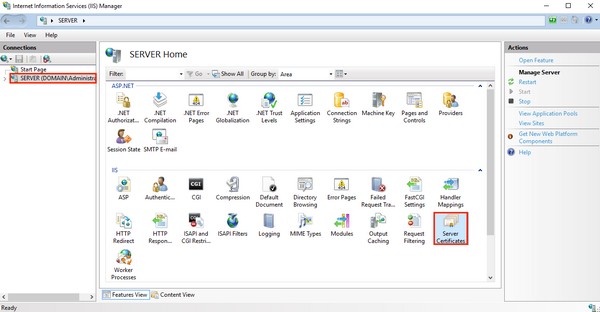
4 На основной странице раздела server name (центральная панель), кликните дважды в секции IIS на раздел Server Certificates.
5 На странице раздела Server Certificates page (центральная панель),в меню действия в правой панели (Actions menu),кликнуть на Complete Certificate Request.
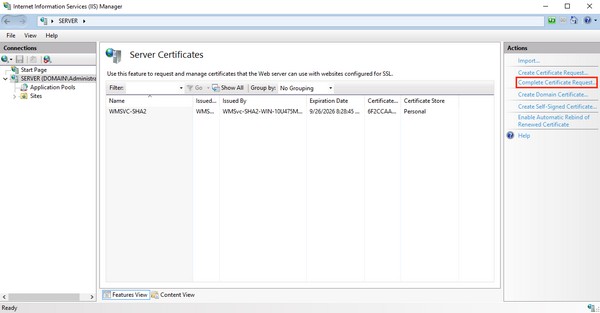
6 In the Complete Certificate Request wizard, on the Specify Certificate Authority Response page, do the following and then click OK:
File name containing the Click the … box and browse to and select the .cer file certificate authority's response: (e.g., your_domain_com.cer) that DigiCert sent to you.
Friendly name: Type a friendly name for the certificate. The friendly name is not part of the certificate; instead, it is used to identify the certificate. We recommend that you add DigiCert and the expiration date to the end of your friendly name, for example: yoursite-digicert-(expiration date). This information helps identify the issuer and expiration date for each certificate. It also helps distinguish multiple certificates with the same domain name.
Select a certificate store In the drop-down list, select Web Hosting. for the new certificate:
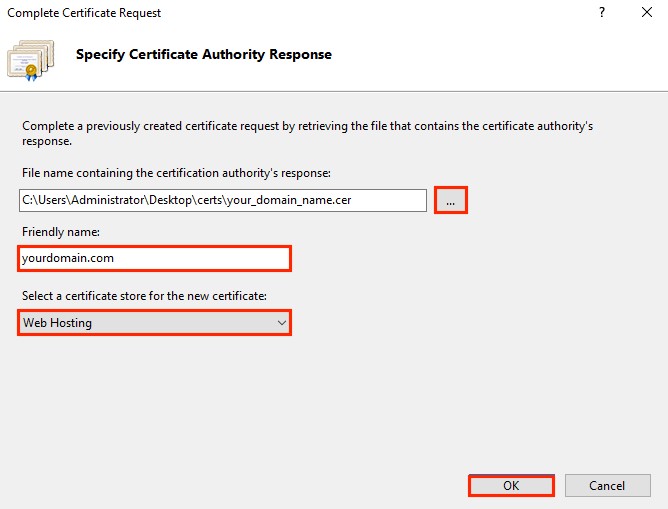
7 Now that you've successfully installed your SSL certificate, you need to assign the certificate to the appropriate site.
Assign SSL Certificate
8 In Internet Information Services (IIS) Manager, in the Connections menu tree (left pane), expand the name of the server on which the certificate was installed. Then expand Sites and click the site you want to use the SSL certificate to secure.
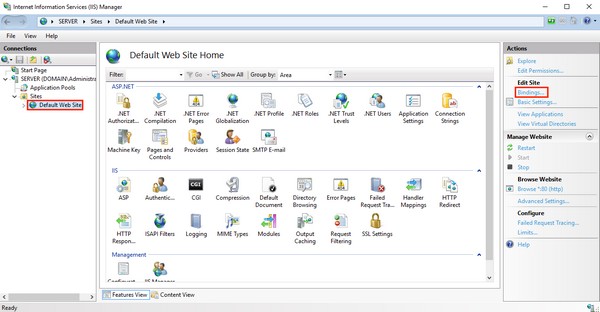
9 On the website Home page, in the Actions menu (right pane), under Edit Site, click the Bindings… link.
10 In the Site Bindings window, click Add.
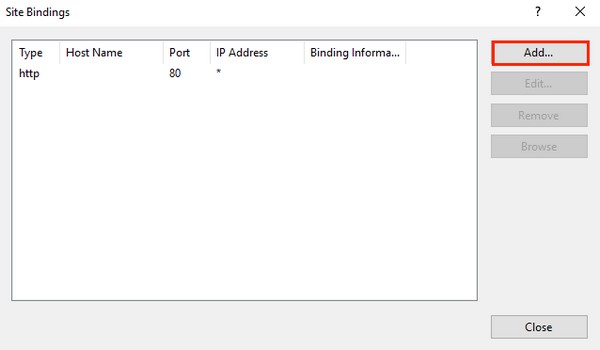
11 In the Add Site Bindings window, do the following and then click OK:
Type: In the drop-down list, select https.
IP address: In the drop-down list, select the IP address of the site or select All Unassigned.
Port: Type port 443. The port over which traffic is secure by SSL is port 443.
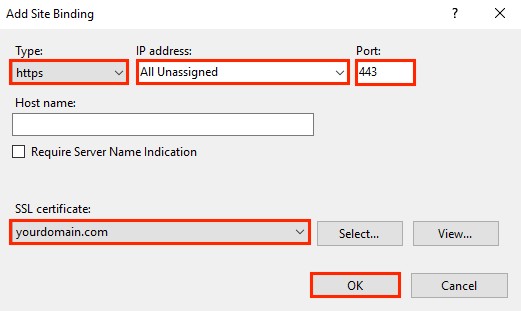
12 Your SSL certificate is now installed, and the website configured to accept secure connections.
SSL certificate: In the drop-down list, select your new SSL certificate (e.g., yourdomain.com).
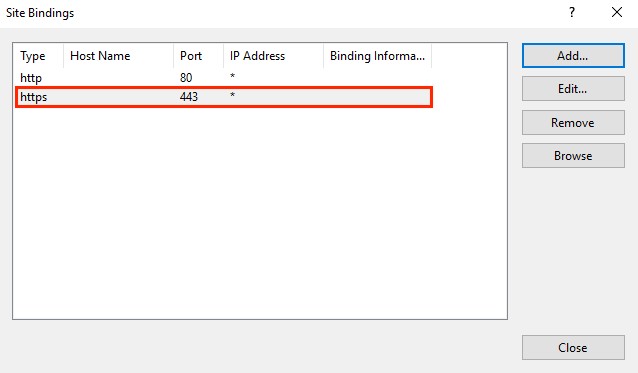
---------
(Multiple Certificates) How to install your SSL certificates and configure the server to use them using SNI This instructions explains how to install multiple SSL certificates and assign them using SNI. The process is split into two parts as follows:
Installing and Configuring Your First SSL Certificate
Installing and Configuring All Additional Certificates
Install First SSL Certificate
Do this first set of instructions only once, for the first SSL certificate.
1 On the server where you created the CSR, save the SSL certificate .cer file (e.g., your_domain_com.cer) that DigiCert sent to you.
2 In the Windows start menu, type Internet Information Services (IIS) Manager and open it.
3 In Internet Information Services (IIS) Manager, in the Connections menu tree (left pane), locate and click the server name.

4 On the server name Home page (center pane), in the IIS section, double-click Server Certificates.
5 On the Server Certificates page (center pane), in the Actions menu (right pane), click the Complete Certificate Request… link.

6 In the Complete Certificate Request wizard, on the Specify Certificate Authority Response page, do the following and then click OK:
File name containing the Click the … box and browse to and select the .cer file certificate authority's response: (e.g., your_domain_com.cer) that DigiCert sent to you.
Friendly name: Type a friendly name for the certificate.
The friendly name is not part of the certificate; instead, it is used to identify the certificate.
We recommend that you add DigiCert and the expiration date to the end of your friendly name, for example: yoursite-digicert-(expiration date).
This information helps identify the issuer and expiration date for each certificate. It also helps distinguish multiple certificates with the same domain name.
Select a certificate store In the drop-down list, select Web Hosting. for the new certificate:

7 Now that you've successfully installed your SSL certificate, you need to assign the certificate to the appropriate site.
8 In Internet Information Services (IIS) Manager, in the Connections menu tree (left pane), expand the name of the server on which the certificate was installed. Then expand Sites and click the site you want to use the SSL certificate to secure.

9 On the website Home page, in the Actions menu (right pane), under Edit Site, click the Bindings… link.
10 In the Site Bindings window, click Add.

11 In the Add Site Bindings window, do the following and then click OK:
Type: In the drop-down list, select https. IP address: In the drop-down list, select the IP address of the site or select All Unassigned. Port: Type port 443. The port over which traffic is secure by SSL is port 443. SSL certificate: In the drop-down list, select your new SSL certificate (e.g., yourdomain.com).

12 Your first SSL certificate is now installed, and the website configured to accept secure connections. Install Additional SSL Certificates
To install and assign each additional SSL certificate, repeat the steps below, as needed.
1 On the server where you created the CSR, save the SSL certificate .cer file (e.g., your_domain_com.cer) that DigiCert sent to you.
2 In the Windows start menu, type Internet Information Services (IIS) Manager and open it.
3 In Internet Information Services (IIS) Manager, in the Connections menu tree (left pane), locate and click the server name.

4 On the server name Home page (center pane), in the IIS section, double-click Server Certificates.
5 On the Server Certificates page (center pane), in the Actions menu (right pane), click the Complete Certificate Request… link.

6 In the Complete Certificate Request wizard, on the Specify Certificate Authority Response page, do the following and then click OK:
File name containing the Click the … box and browse to and select the .cer file
certificate authority's response: (e.g., your_domain_com.cer) that DigiCert sent to you.
Friendly name: Type a friendly name for the certificate.
The friendly name is not part of the certificate; instead, it is used to identify the certificate.
We recommend that you add DigiCert and the expiration date to the end of your friendly name, for example: yoursite-digicert-(expiration date).
This information helps identify the issuer and expiration date for each certificate. It also helps distinguish multiple certificates with the same domain name.
Select a certificate store In the drop-down list, select Web Hosting.
for the new certificate:

7 Now that you've successfully installed your SSL certificate, you need to assign the certificate to the appropriate site.
8 In Internet Information Services (IIS) Manager, in the Connections menu tree (left pane), expand the name of the server on which the certificate was installed. Then expand Sites and click the site you want to use the SSL certificate to secure.

9 On the website Home page, in the Actions menu (right pane), under Edit Site, click the Bindings… link.
10 In the Site Bindings window, click Add.

11 In the Add Site Bindings window, do the following and then click OK:
Type: In the drop-down list, select https.
IP address: In the drop-down list, select the IP address of the site or select All Unassigned.
Port: Type port 443. The port over which traffic is secure by SSL is port 443.
Host name: Type the host name that you want to secure.
Require Server After you enter the host name, check this box.
Name Indication: This is required for all additional certificates/sites, after you've installed the first certificate and secured the primary site.
SSL certificate: In the drop-down list, select an additional SSL certificate (e.g., yourdomain2.com).
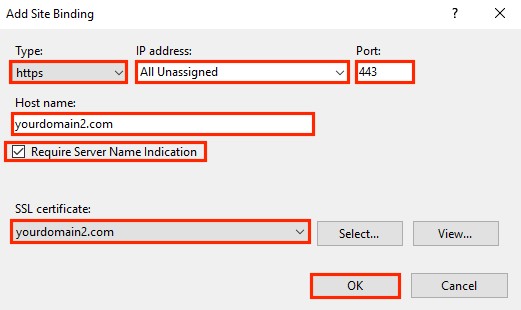
12 You have successfully installed another SSL certificate and configured the website to accept secure connections.